7 Questions to Help You Pick the Right Front-Yard Fence
http://decor-ideas.org 06/21/2014 23:13 Decor Ideas
Choosing a front-yard fence should be a calculated decision — a fence changes the way your home is seen, affects the layout of the landscaping and lasts, typically, the life of your home. And with the hundreds of fencing options out there, it’s no small hurdle to find a fence that fits your home. Andrea Nilsen of Nilsen Landscape Design and John Hreno of Terra Ferma Landscapes know the dilemma well, and they helped compile these seven questions to consider when choosing a front-yard fence.
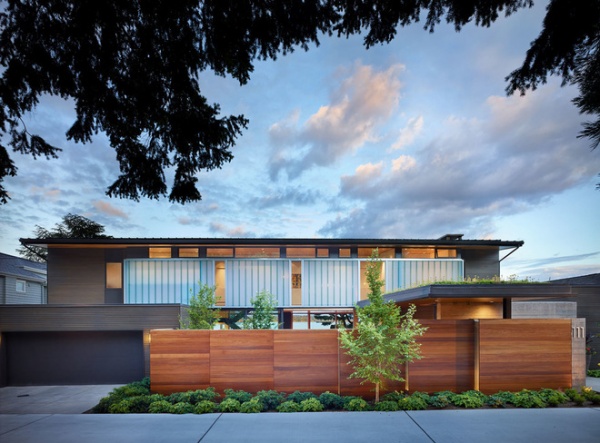
Preliminary Questions
The first four questions consider the particulars of your situation and what design elements are already in place.
1. What do you want from your fence design? If the fence’s function is to define the property line, keep in children or animals, or be an aesthetic complement to the house, then the best choice may be a lower fence that is both functional and can connect visually with the entire house. If you’re looking for privacy, a higher fence is needed — 6 feet is the typical height for a privacy fence. A privacy fence will have a less direct visual connection with the house and usually engages more with the second story.
Hreno also asks, “Is [the fence] intended to be a strong visual, or should it disappear? Does it have a dual purpose, or should it be an art object?” Considering your overall aspirations will help narrow your fence options from the start. Also research local regulations before you begin your fence design. Know height restrictions and where, legally, the fence can be set.
Shown: A horizontal board-on-board privacy fence blocks the home’s first-floor view but connects visually and stylistically with the second story.
See more photos of privacy fences
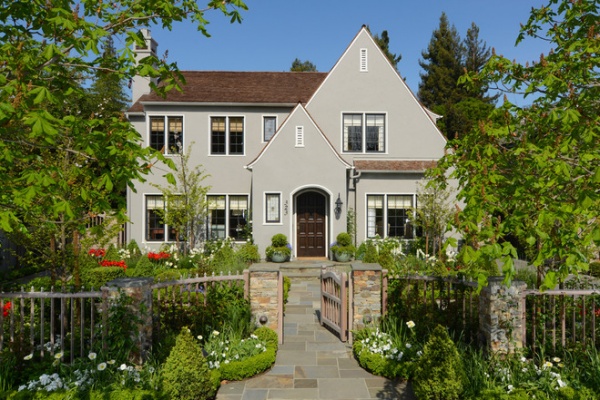
2. How do you and guests approach your home? “It’s all about that glimpse over the fence,” Nilsen says, emphasizing the need to consider how people approach your home. Go out and see what your house looks like from the sidewalk and across the street. Then think of how you approach your home and how you will see your fence from inside. As Nilsen says, often “you are seeing [your fence] from within, rather than from beyond.”
There’s a big difference between an overhead CAD drawing of your yard and the real view from the street, so go outside and get the actual perspective.
Shown: A low, semiprivate fence allows foliage to grow in front and behind the fence, giving both the homeowners and neighbors good views.
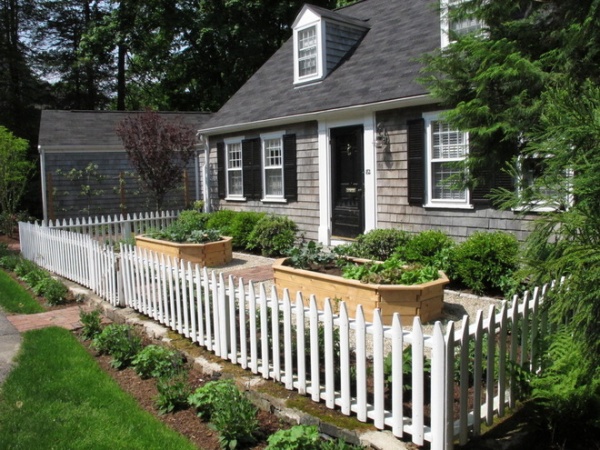
3. What’s your home’s style? The next step is to evaluate your home’s architecture. Look at its style and palette of colors. For fencing you usually want to stay within a home’s theme. Nilsen says the best designs take the home’s style and carry the notion through.
Nilsen also sticks with an easy design formula. She says, “Simple home, simple fence; ornate home, ornate fence.” It sounds elementary, but it works.
Shown: This white picket fence complements the traditional style of the wood-shingled Cape Cod.
Find your home’s style
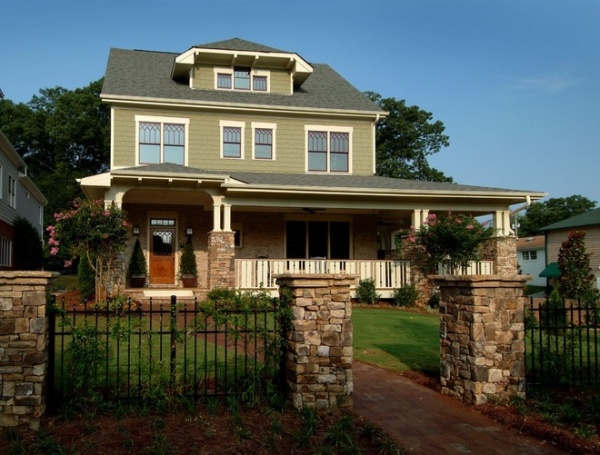
Getting Into Design
The next step is to evaluate the design elements you want in your fence, making sure your choices will enhance your home’s architecture.
4. Are there tie-ins from the house you can add to the fence? Tie-ins are easy ways to integrate your fence into your home’s architecture. “If you have a stone foundation that’s exposed,” Nilsen says, “you can have stone columns with your fence.” The repetition of elements reinforces the fence’s association with the home’s architecture.
Shown: There’s brick siding on this home’s first floor and stone columns on the porch; this fence’s stone posts link it to the home’s design.
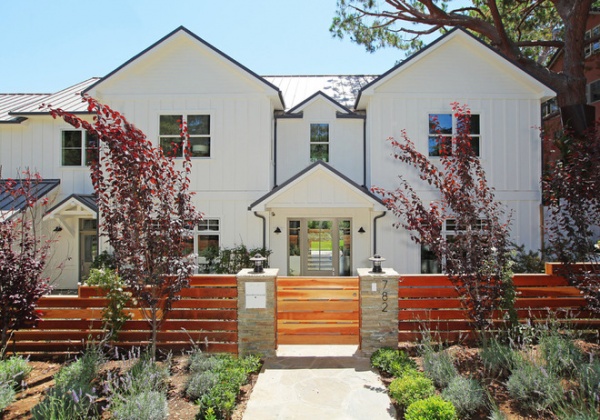
5. Do you want to complement or contrast your home’s style? “Not everything is supposed to match or coordinate together,” Hreno says. “Sometimes the uniqueness of things makes each one stand out on their own.”
Considering your home’s style doesn’t mean you have to imitate it. There are times that offering a contrast of color or design will open up a new “dialogue between things,” Hreno says. Contrasting materials can help each individual part stand out, making a statement with both house and fence design.
Shown: On this contemporary farmhouse, the horizontal wooden fence reinforces the symmetrical balance of the home’s architecture, but the contrast between the wood and the white siding highlights both the fence and the siding.
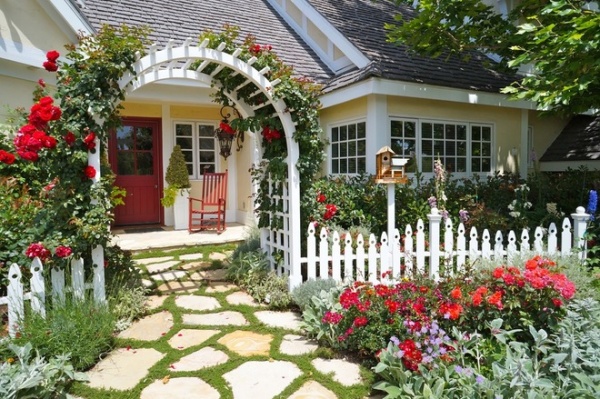
The Final Touches
A fence doesn’t exist in a void, so while you’re considering your home and fence design, don’t forget the supplementary parts of the fence.
6. What plants can help your fence stand out (or disappear)? For foliage Nilsen wants clients to consider how they will be enjoying the space. If they’ll be using the front yard for gardening or entertaining, plants may best serve inside the barrier. If the space has heavy pedestrian traffic, it is neighborly to plant some flowers on the exterior of the fence.
Trees provide visual punctuation along a fence, but “it all depends on if you want contrast,” Nilsen says, “or if you want visual harmony.” For a cottage with direct sunlight and a white picket fence, some bright flowers can bring a welcome shot of high contrast. In a wooded area, a minimalist fence (like a split rail or black metal) can recede nicely.
Shown: A white picket fence is the perfect backdrop for bursts of color, accentuating this home’s cottage charm.
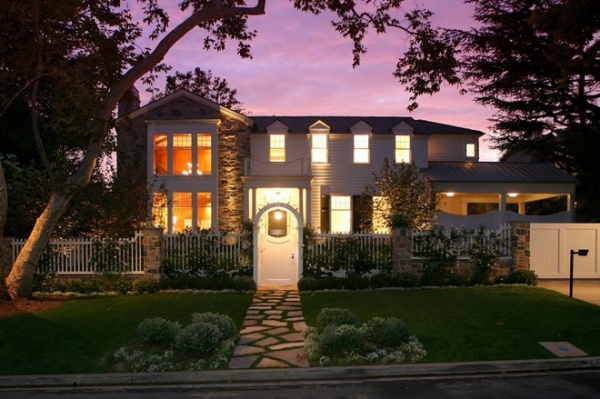
7. What accents can you add to your fence? A gate will operate as the capstone of your design. While style choices still rest on function (security, accessibility), a gate also allows for more creative details. “Think about the design and hardware,” Nilsen advises. “The details of the gate will make the fence feel custom.”
And then there’s lighting — don’t overlook the half of the day when it’s dark. “You should be lighting something,” Nilsen says. Focus lights on the entryway and any points of visual emphasis (like custom posts). Or you may choose to let the fence slip into the dark. “At night,” Nilsen allows, “it’s OK for a fence to recede.”
Shown: Over the gate a light shines to call attention to the entrance and help light the path.
More:
How to Light Your Landscape for Drama and Function
Landscape Detail: Do Fence Me In12 Great Fences and Gates
Tell us: What was your process for choosing a front-yard fence? How does your fence work with your home’s design?
Related Articles Recommended












